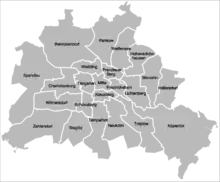Weissensee (Berlin)
Weißensee (German: [ˈvaɪ̯sn̩ˌzeː] (![]() listen)) is a locality in the borough of Pankow in Berlin, Germany, that takes its name from the small lake Weißer See (literally "White Lake") within it. Before Berlin's 2001 administrative reform, Weißensee was a borough in its own right, consisting of the localities of Weißensee, Heinersdorf, Blankenburg, Karow and Stadtrandsiedlung Malchow. A fictional German-language TV series by the same name is set in the borough between 1980 and 1990 during the communist era.
listen)) is a locality in the borough of Pankow in Berlin, Germany, that takes its name from the small lake Weißer See (literally "White Lake") within it. Before Berlin's 2001 administrative reform, Weißensee was a borough in its own right, consisting of the localities of Weißensee, Heinersdorf, Blankenburg, Karow and Stadtrandsiedlung Malchow. A fictional German-language TV series by the same name is set in the borough between 1980 and 1990 during the communist era.
Weißensee | |
|---|---|
Locality of Berlin | |
 The lake Weißer See | |
 Coat of arms | |
Location of Weißensee in Pankow district and Berlin  | |
 Weißensee  Weißensee | |
| Coordinates: 52°33′00″N 13°28′00″E | |
| Country | Germany |
| State | Berlin |
| City | Berlin |
| Borough | Pankow |
| Founded | 1313 |
| Area | |
| • Total | 7.93 km2 (3.06 sq mi) |
| Elevation | 90 m (300 ft) |
| Population (2008-06-30) | |
| • Total | 45,485 |
| • Density | 5,700/km2 (15,000/sq mi) |
| Time zone | UTC+01:00 (CET) |
| • Summer (DST) | UTC+02:00 (CEST) |
| Postal codes | (nr. 0302) 13086, 13088 |
| Vehicle registration | B |
History
Weißensee was first mentioned in 1313 as Wittense. The first settlers subsisted on fishing and established themselves on the eastern shore of the lake, where an old trade route connected Berlin with Szczecin (Stettin) and the Baltic Sea – today the Bundesstraße 2 federal highway.
From 1914 onwards, the Weissensee Studios produced a number of silent films including works by Fritz Lang and the expressionist film The Cabinet of Dr. Caligari.
As Berlin's least inhabited district, it has been overshadowed historically by its neighboring boroughs Prenzlauer Berg and Pankow. However its popularity is increasing due to its proximity to the hip but expensive Prenzlauer Berg. Its trams make reaching Mitte very convenient.
Overview
Weißensee is appreciated as a good choice for people seeking for a balance between urban life and seclusion in a peaceful district of Berlin. The immediate area around the lake Weißer See is characterized by its historical architecture, numerous places of interest, parks, lakes and activities. The art school Kunsthochschule Berlin-Weißensee Weißensee Academy of Art Berlin is of national rank. The Radrennbahn Weißensee cycling track has also hosted popular music concerts. The largest concert ever held here was a Bruce Springsteen concert on July 19, 1988. Springsteen played before an estimated crowd of 300,000. At Weißensee Cemetery, one of Europe's largest Jewish cemeteries, notable people like the painter Lesser Ury and the publishers Samuel Fischer and Rudolf Mosse are buried.
References
External links
![]() Media related to Weißensee at Wikimedia Commons
Media related to Weißensee at Wikimedia Commons
- tic-berlin: tourist & historical information about Weißensee
- Gustav-Adolf Street
- Article from Exberliner magazine
